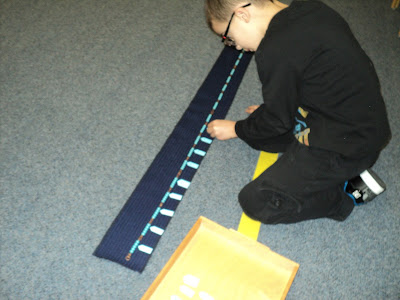This is a picture of the Bead Chain Material Cabinet.
 |
| The Bead Chain Material Cabinet |
This material illustrates the squares and cubes of numbers from 1 to 10. The chains sitting on the shelves illustrate the squares of numbers while the hanging chains illustrate the cubes of numbers.
 |
| A Close Up of the Shelves |
The top shelf of the cabinet holds boxes which contain colour coordinated numbered arrows for the squares (short boxes) and cubes (tall boxes) of numbers. The child must be familiar with numbers 1 to 100 for the short chains and 1 to 1000 for the long chains.
 |
| The Boxes Containing Numbered Arrows |
This material is used for many different purposes in the Montessori casa (preschool) classroom and in the lower elementary classroom. Children often begin work with this material at the age of 4 (JK aged children).
This material takes children from the concrete to the abstract. At the simplest level, it is a counting exercise to practice the order of numbers. That after 39 comes 40 etc. At the next level, this material illustrates skip counting, counting by ones, twos, threes, etc. all the way up to counting by tens. Towards the end of the casa program and in the lower elementary, this material is indirect preparation for the memorization of the multiplication tables. This material also illustrates the squares and cubes of these numbers and their relationships with each other.
Brothers D. & J. are working with the Square Chain of 8. The boys have set out the number arrows and are counting the beads on the chain.
You will notice that every eighth bead has a number arrow. The following photograph is part of the completed work. (Click on the images to make them larger.) In Skip Counting the boys are saying "8, 16, 24, 32, 40, 48, 56, 64".
The square of 8 has been placed at the end of the chain. The square of 8 contains 64 beads.
When the chain is folded you get 8 sets of 8 or 8 x 8. This is the same as 8 squared which equals 64.
S. is working with the Cube Chain of 5. He has set out the chain and has placed the corresponding arrows on the tray. In skip counting, he is saying "5, 10, 15, 20 etc.". As he counts the beads on the chain, he places an arrow on every fifth bead. In skip counting S. is saying "5, 10, 15, 20...".
The Cube Chains make sets of squares. Once S. has skip counted the chain, he has been shown that the first five sections of the chain can be folded to make a square. The first square is placed at 25, the next at 50 etc.
The sets of squares stack up on top of one another to make a cube. The Cube of 5 has been placed at the end of the chain.
 |
The Cube Chain of 5 contains 5 sets of 5 sets of 5 which is 5 x 5 x 5. This is 5 sets of squares of 5 which is 5 x 5 squared. This gives you 5 cubed which equals 125 beads.
The bead chains are a very popular activity in our classrooms. They are a visually stunning piece of material that require both manual dexterity and persistence. The younger children look on with awe and admiration as their older classmates work with this magical material. Throughout the day you will often see the younger children walk past the cabinet and touch the chains ever so gently as if to say "One day I will work with you.". It is a big piece of work that all of our students aspire towards.











So interesting blog, really this type of activity helps to create a successful person. Certain types of Montessori toys help in this type of education system. Montessori education provides an environment of carefully chosen materials which helps the children to work, concentrate, and joy. Special Montessori material introduces the most basic concepts of mathematics and literacy through games and activities.
ReplyDeleteNice post, thanks for sharing. The Bead Chains are a fantastic Montessori Math Materials that helps children explore skip counting, multiplication, and patterns. Their tactile nature promotes hands-on learning, making abstract math concepts more concrete. By manipulating the colorful chains, children develop a deeper understanding of numbers, sequences, and arithmetic operations, enhancing their mathematical foundation.
ReplyDelete